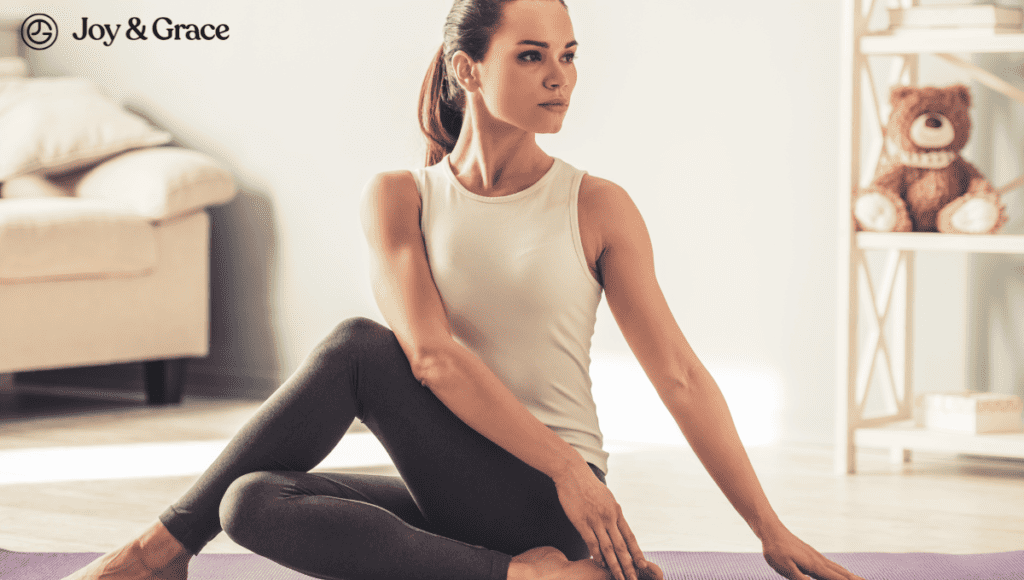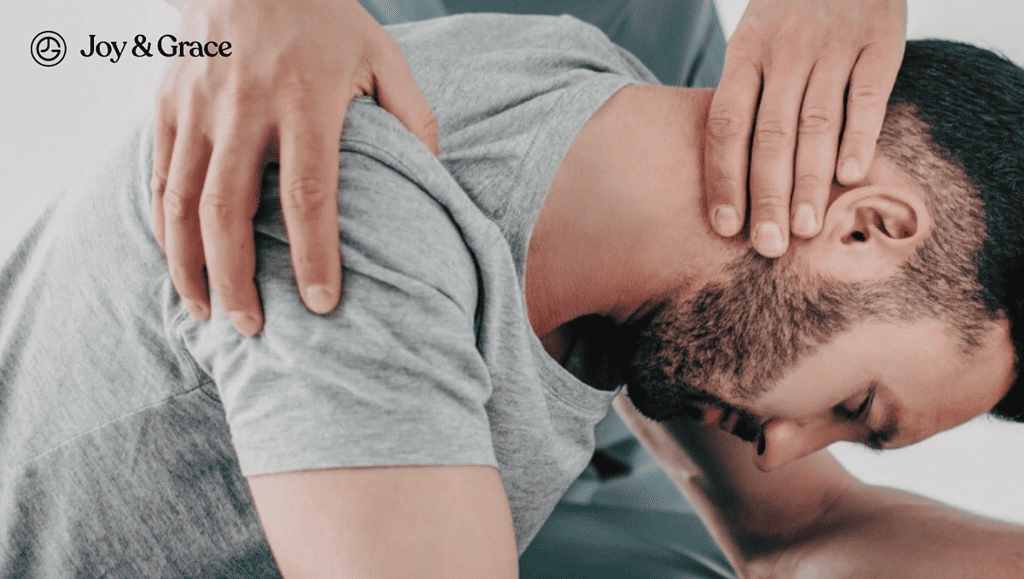Discover the healing power of yoga for shoulder pain. Shoulder pain can be alleviated and even prevented by learning some simple yoga poses.
If you've ever experienced shoulder pain, you're not alone. Sometimes, even the practice of yoga itself can inadvertently contribute to the pain.
We’ll explore the delicate balance between yoga and shoulder pain. We'll delve into the factors that can cause or exacerbate shoulder pain during yoga practice. And equally important, we'll discover how specific yoga poses and techniques can be tailored to target and relieve that pain.
Can Yoga Cause Shoulder Pain?
Shoulder pain is a common ailment in our increasingly sedentary society. It's unsurprising that many may take up yoga to relieve the pain. However, there have been cases where certain yoga poses can actually lead to shoulder pain.
In a survey of 2620 yoga-practicing participants, 19% of yoga injuries involved the shoulder. In another survey, 35% of respondents reported shoulder injuries due to the Chaturanga pose.
According to a study, the following may put you at risk of developing shoulder pain during yoga:
- Overexertion
Overdoing certain poses or pushing yourself too hard can lead to overuse injuries or strains in the shoulder area. This is common in poses involving balancing your entire body on one arm or backbends.
- Poor Alignment
Incorrect alignment during poses that involve the shoulders can lead to strain and discomfort. If the shoulders are not properly aligned, it can stress the shoulder ligaments and muscles excessively.
- Inadequate warm-up
Failing to warm the shoulders before engaging in strenuous yoga poses can increase the risk of shoulder pain or injury.
- Pre-existing Conditions
If you have pre-existing shoulder issues, certain yoga poses may exacerbate these conditions and cause pain.
- Inexperienced Instructors
The experience and expertise of your yoga instructor can play a role in preventing injuries. An experienced instructor will provide proper guidance on alignment and adjustments to help avoid shoulder strain.
What Makes The Shoulders Prone To Injuries In Yoga?
The shoulders are a complex and highly mobile joint of the human body. But their mobility also makes them susceptible to injuries, even in gentle activities like yoga. The shoulder joint is composed of three bones:
- The humerus (upper arm bone),
- The scapula (shoulder blade), and
- The clavicle (collarbone)
A network of muscles, tendons, and ligaments connects these bones. The complexity of this joint allows for a wide range of motion but also makes it less stable than other joints.
Because of how the shoulder is built, it can get hurt if you do not keep it in the correct position when doing poses that move the shoulder.
The stability of the shoulder joint relies heavily on the surrounding muscles, such as the rotator cuff muscles. You may strain the shoulder muscles if you lack the shoulder and upper body strength to support your body weight in certain yoga poses. This is especially true if you attempt advanced poses before building adequate strength.
What Is the Most Common Shoulder Injury in Yoga?
The most common shoulder injury in yoga is usually related to overuse and strain rather than a specific injury. Yoga practitioners may experience rotator cuff tendinitis, bursitis, or shoulder muscle strains. These injuries can be due to the risk factors we mentioned earlier.
According to a study, yoga-related injuries commonly occur in the supraspinatus muscle. This muscle is part of the rotator cuff and assists the deltoid (shoulder muscle) in lifting the arm overhead. Yoga may also cause labrum tears in your shoulder.
Why Do I Have Shoulder Pain In Chaturanga?
Chaturanga Dandasana is a foundation pose in many yoga styles, especially Ashtanga. However, it can sometimes result in shoulder pain if not done correctly.
Shoulder pain during Chaturanga Dandasana, often referred to as a low plank pose, can result from various factors, such as:
- Weak Muscles
If your shoulder muscles are weak or unconditioned, they may struggle to support your body weight in this pose.
- Improper Alignment
Incorrect alignment can strain the shoulder joints and lead to pain. This can include:- Shoulders dipping too low
- Shoulders pushed too far forward beyond your wrists
- Lack of Core Engagement
Chaturanga also requires core strength to support your body. If your core is weak, all the weight may be distributed to the shoulders rather than across the body, leading to pain.
- Overuse or Fatigue
Repeating Chaturanga frequently during a yoga session can lead to overuse and fatigue in the shoulder muscles.
Can Yoga Reduce Shoulder Pain?
While improper form can exacerbate issues, when done mindfully with proper alignment, yoga can actually:
- strengthen shoulder muscles,
- improve posture and mobility, and
- teach breathing techniques that provide holistic relief for shoulder pain.
Many studies have credited yoga with helping relieve various forms of chronic pain, including chronic shoulder pain. Yoga is sometimes recommended as an add-on for treating shoulder pain caused by various conditions. It also helps you manage the psychological aspect of chronic pain, providing a holistic approach to pain management.
It's important to note that yoga may not be effective in every case; outcomes depend on the person and situation. For example, in one study, yoga was effective in relieving shoulder and arm pain among breast cancer patients. However, in another study, yoga had no added benefit for patients with frozen shoulders.
The bottom line is: While yoga can be a helpful tool for managing shoulder pain, it's not an absolute solution. It’s only an aid that can help relieve pain when done correctly.
Is Yoga Good For Neck And Shoulder Pain?
Yes, yoga is good for both neck and shoulder pain. According to a study, yoga was more effective in relieving chronic neck pain compared to a home-based exercise program.
In another survey, researchers examined how Hatha yoga can benefit young women with shoulder pain.
Hatha yoga is a traditional form focusing on physical postures, breath control, and meditation. It serves as a foundational practice for many modern yoga styles.
The study revealed that young women who practiced Hatha yoga three times a week for 16 weeks experienced improved health. The participants had improved muscle strength, flexibility, and joint function.
Specifically, yoga is thought to help reduce inflammation in the body. It may also increase the activity of enzymes that reduce swelling. With these results in mind, the study concluded that Hatha yoga may effectively prevent shoulder pain among women.
How Do I Do Yoga With A Bad Shoulder?
Yoga can be adapted to accommodate a bad shoulder or shoulder injury. However, it's essential to prioritize safety and consult with a healthcare professional before starting or modifying any yoga practice. They can provide specific guidance and recommendations based on your condition.
Here are some general tips for practicing yoga with a bad shoulder:
- Choose the Right Yoga Style
Consider practicing gentle and restorative yoga, emphasizing slow, controlled movements and relaxation. These styles can help you improve flexibility and strength in a safe and supportive way.
- Modify Poses
Modify yoga poses to avoid putting excessive stress on your injured shoulder. Here are some modifications to consider:- Avoid poses that require weight-bearing on the affected shoulder.
- Use props like blocks, straps, or a wall for pose support and stability. We’ll list them down later.
- Perform one-arm versions of poses if necessary.
- Keep your movements within a pain-free range of motion.
- Focus on Breath and Mindfulness
Pay attention to your breath and practice mindfulness. Breathing deeply can help you relax and reduce tension, which may aid in shoulder pain relief.
- Warm-Up
Perform gentle warm-up exercises to increase blood flow and prepare the muscles and joints for movement.
- Strengthen Supporting Muscles
Work on strengthening the muscles surrounding the injured shoulder. A physical therapist can provide exercises tailored to your specific condition.
- Be Patient
Listen to your body and avoid pushing yourself too hard. Progress may be slower than you're used to, but avoiding aggravating your shoulder injury is essential.
- Rest and Recover Properly
Give your shoulder adequate time to rest and heal. This may mean skipping certain yoga classes or poses until you fully recover.
- Communicate with Your Instructor
If you attend yoga classes, inform them about your shoulder injury and any necessary modifications. A knowledgeable instructor can suggest alternative poses and adjustments to keep you safe.
- Consider Private Sessions
If you have a specific shoulder issue, consider taking one-on-one sessions with a yoga instructor who can tailor the practice to your needs.
Remember that healing takes time. It's crucial to prioritize your shoulder's health over pushing yourself too hard in your yoga practice.
What Are Some Yoga Props That Can Help With Shoulder Injuries?
Yoga props can be helpful if you have shoulder injuries, as they provide support and stability during yoga practice. Here are some yoga props that can be beneficial:
- Yoga Blocks
Yoga blocks can support your hands in poses where you need to place your hands on the floor, like Downward-Facing Dog or Plank Pose. They can help reduce the strain on your shoulders by elevating the floor and allowing you to maintain proper alignment.
- Yoga Straps
Yoga straps can extend your reach and make it easier to hold poses without straining your shoulders.
- Bolsters
Bolsters can provide support and comfort during restorative yoga poses. You can use them to prop yourself up in poses. This can make the poses more gentle on your shoulders while providing a deep stretch.
- Blankets
Blankets can be folded and used as padding under your shoulders in poses where you lie on your back. This can help reduce pressure on the shoulders and make the pose more comfortable.
- Wall
The wall can be an excellent prop for shoulder rehabilitation. You can use it to perform wall-assisted stretches and exercises.
- Pillow or Cushion
Placing a pillow or cushion under your head in certain poses can help alleviate pressure on the neck and shoulders. This is particularly useful in restorative poses.
- Yoga Wheel
Yoga wheels can be used to stretch and release shoulder tension gently. Rolling the wheel along the upper back can provide a soothing massage and improve mobility.
- Foam Roller
Like a yoga wheel, foam rollers can release shoulder and upper back tension. They can also help improve posture and shoulder mobility when used in self-massage and stretching exercises.
While yoga props can aid in alleviating shoulder pain and protecting against further injuries, they are not a cure-all. Proper technique still plays a more significant role in protecting your shoulders.
What Are Some Beginner-Friendly Yoga Poses For Shoulder Pain?
Please make sure to talk with a healthcare professional before attempting these poses. Make sure to mention any underlying conditions to avoid any complications.
Here are some beginner-friendly yoga poses to help relieve your shoulder pain:
Thread the needle pose is a deep stretch that can help loosen tight shoulder, neck, and upper back muscles.
- Start by getting on all fours on the floor with your hands flat on the ground and your wrists under your shoulders. The knees should be below the hips.
- Raise your right arm toward the ceiling as you open your chest. Look up and to the right.
- Move your right arm under the chest and toward the mat. Your right hand should be pointing to the left side.
- Keep moving your right arm under your left arm until your right shoulder is on the mat and you feel a stretch.
- Hold this pose for 30 to 45 seconds, then switch sides.
The Cat-Cow Pose is a gentle stretch that can help ease tightness in the neck and shoulders. If you have neck pain, ensure your head is aligned with your body. Also, make sure your shoulders aren't close to your ears.
- Start on all fours, with your legs right under your shoulders and your hips right above your knees, with your toes untucked.
- Put your head in the middle and look at the floor with your eyes.
- As you take a deep breath, lift your head and tailbone and let your belly drop toward the floor.
- Raise your head so you can see straight ahead.
- As you let your breath out, round your back while ensuring your shoulders and knees stay in place.
- Roll your shoulders toward your heart, let your chin fall to your chest, and look at your belly.
- Follow the pace of your breath and repeat as many times as you need to.
Eagle Arms is a pose that focuses on the shoulders and upper back. Because this pose is a little intense for your shoulder blade muscles, don’t do it if you have a rotator cuff injury.
- To do this pose, keep your legs crossed and your arms in front of you while in a seated position.
- Bring your hands together and cross your right arm over your left arm at the elbow.
- Raise your arms and move your hands away from your face.
- After a few deep breaths, switch sides.
The Seated Spinal Twist is excellent for relieving shoulder and upper back tension.
- Sit with your legs straight.
- Bend one knee and place the foot outside the opposite thigh.
- Twist your upper body to the side, placing the opposite elbow outside the bent knee.
- This pose stretches and releases muscle tension in the shoulders while promoting spinal flexibility.
If you have a severe shoulder injury or discomfort, practice this pose gently and avoid excessive twisting.
This pose stretches the entire back, including the shoulders, and can help alleviate shoulder tension.
- Stand with your feet hip-width apart.
- Exhale as you bend forward from your hips, reaching toward the ground or your shins.
- Let your head hang loose.
- You can clasp your elbows for a deeper stretch.
- This pose elongates the thoracic spine, releases shoulder tension, and promotes relaxation.
If you have severe shoulder or lower back problems, bend your knees slightly to reduce strain on these areas.
Sphinx Pose helps strengthen and open up the chest and shoulders, making it beneficial for relieving shoulder tension. This pose encourages a gentle backbend and stretches the front of the shoulders.
- Lie face down on your mat with your legs extended and your forearms on the ground, elbows beneath your shoulders.
- Gently lift your chest and head while keeping your pelvis grounded.
This pose enhances shoulder flexibility and releases upper back and shoulder tension.
- Stand or sit up straight, then reach both arms behind your back.
- Try to clasp your hands together, one from above your shoulder and one from below.
- You can also use a strap to bridge the gap between your hands.
- Gently lift your arms behind you to open your chest and shoulders.
This pose strengthens the shoulders while promoting balance and flexibility.
- In a standing position, keep your feet wide apart, with one foot forward and the other foot turned out.
- Extend your arms out parallel to the ground, keeping your shoulders relaxed.
Seated Forward Bend stretches the entire back, including the shoulders, and can help release shoulder tension. This pose stretches the shoulders, hamstrings, and lower back while promoting relaxation.
- Sit with your legs straight.
- Inhale and lengthen your spine, then exhale as you fold from your hips, reaching toward your toes.
These poses should not replace any professional treatments or therapies you may use for shoulder pain. Each pose can be modified for personal comfort. And remember never to push yourself into a painful position.
How Should My Shoulders Align In Chaturanga?
The alignment of your shoulders in Chaturanga is crucial to avoiding shoulder pain. With proper alignment, you can practice this pose without causing or worsening shoulder pain.
- First, start in a plank position with your palms grounded directly under your shoulders.
- Keep your feet hip-width apart and push energetically back through your heels.
- Engage your core to maintain a straight line from the crown of your head to your heels.
As you lower into Chaturanga:
- Bend your elbows straight back, hugging them into your sides.
- Your shoulders should be level with or above your elbows, not dipping down toward the mat. Picture creating a 90-degree angle with your arms. Ensure your elbows are slightly behind your wrists and not directly above them.
- To ensure your shoulders don't dip too low, keep your head and torso moving forward as you lower your body.
Chaturanga can be challenging. But with practice and attention to alignment, it can be successfully incorporated into your yoga practice. If you still have trouble with the Chaturanga, there are simple modifications you can make to avoid shoulder injuries.
How Can I Modify Chaturanga To Avoid Shoulder Injury?
To avoid injury during Chaturanga and ease any existing shoulder pain, consider these modifications:
- Knee-Chest-Chin Pose
Lessen the burden on your shoulders by dropping your knees to the mat before bending your elbows in Chaturanga. Then, lower your chest and chin to the floor while keeping your hips elevated. This modification can help protect your shoulders if you're a beginner or recovering from an injury.
- Keep Your Elbows Close
Keep them tucked into your body rather than flaring your elbows to the sides. This maneuver can contribute to better shoulder alignment and reduce strain.
- Use Props
If you find it challenging to keep proper form, try using some of the above props. They can help you maintain correct alignment and ensure you don’t put undue stress on your shoulders.
- Gentle Chaturanga
You can try a gentler Chaturanga to relieve pressure on the shoulders. Lower yourself to the ground, release your toes, and push your chest up for a Cobra pose.
How Do I Relieve Soreness In My Neck And Shoulders After My Yoga Session?
A little soreness is normal after a yoga session and nothing to worry about. Still, here are several techniques you can use to relieve soreness in the neck and shoulder:
- Neck and Shoulder Stretches
- Slowly tilt your head from side to side, bringing your ear toward your shoulder, holding each stretch for several breaths.
- Gently roll your neck in circles, both clockwise and counterclockwise.
- Interlace your fingers behind your back.
- Stretch your arms straight while squeezing your shoulder blades together.
- Neck Rolls
- Drop your chin to your chest and roll your head slowly from side to side, allowing your ear to approach each shoulder. Take it slow, and use your breath to help you relax.
- Shoulder Rolls
- Shrug your shoulders toward your ears and then roll them back and down in a circular motion. Repeat in both directions.
- Wall Angels
- Stand with your back against a wall, raise your arms to shoulder height, and bend your elbows at 90 degrees.
- Slowly slide your arms up and down the wall, focusing on keeping your elbows and wrists in contact with the wall. This helps improve shoulder mobility and relieve soreness.
- Self-Massage
- Gently massage the tense areas with your opposite hand or a massage ball. Focus on knots and tight spots in the neck and shoulders.
- Heat or Cold Therapy
- Apply a warm heating pad or a cold pack to your neck and shoulders for 15-20 minutes. This can help relax muscles and reduce inflammation. Experiment to see which temperature works best for you.
- Breathing and Relaxation
- Lie down in a comfortable position and focus on your breath. Deep, slow breaths can help relax the muscles and reduce soreness. You can also incorporate mindfulness or meditation techniques to calm the mind.
- Hydrate and Rest
- Dehydration can contribute to muscle soreness. Ensure you're adequately hydrated and get enough rest to allow your muscles to recover
How Often Should I Do Yoga For Shoulder Pain Relief?
In yoga, consistency is key. However, no clear-cut guideline exists on how often you should do yoga for shoulder pain. This all depends on:
- The intensity and cause of your shoulder pain
- Other treatments you’re undergoing
- Your experience with yoga
- Your body’s response to yoga
If you're new to yoga, it's recommended that you start slowly. Begin once or twice a week and gradually increase your frequency once you're more comfortable with the movements and can do them without causing further pain. This slow progression will help protect your shoulder from further injury.
One study reported two 60-minute yoga sessions per week to decrease musculoskeletal pain.
However, listening to your body and making changes as needed is essential. If your pain worsens after a yoga session, consider reducing the frequency or altering the intensity of your routine.
Lastly, as with any fitness program, rest and recovery are as important as the workouts. Ensure you're providing your body with enough time to heal between sessions.
How Long Does It Take For Yoga To Help Shoulder Pain?
Again, there are no studies on how long you should practice yoga to relieve shoulder pain. Some people might notice a significant decrease in pain within a few weeks of consistent practice. However, for others, it might take several months.
Are There Any Yoga Poses I Should Avoid If I Have Shoulder Or Neck Pain?
If you're dealing with shoulder or neck pain, there are specific movements you should probably sideline until your discomfort subsides. These include:
- Headstand (Sirsasana) and Handstand (Adho Mukha Vrksasana)
These poses put a significant amount of weight on the shoulders and neck. Avoid them if you have any shoulder or neck issues.
- Shoulderstand (Sarvangasana)
This pose can compress the neck and shoulders, worsening pain or injuries.
- Plow Pose (Halasana)
Like the shoulder stand, Plow Pose can strain the neck and shoulders and should be avoided.
- Bridge Pose (Setu Bandha Sarvangasana)
Be cautious with the bridge pose, especially if you lift your shoulders off the floor. It can strain the neck and shoulders if not done correctly.
- Camel Pose (Ustrasana)
The deep backbend in the camel pose can strain the neck and shoulders, so it's best to avoid it if you have any discomfort in these areas.
- Fish Pose (Matsyasana)
Fish pose can compress the neck, so it's not recommended if you have neck issues.
- Full Wheel Pose (Urdhva Dhanurasana)
This backbend can put a lot of pressure on the shoulders and neck, so it should be approached cautiously or avoided altogether if you have pain or injuries.
Takeaway
At its heart, yoga is about unifying your body and mind. It prioritizes care and choosing movements that serve you best. But care must be taken with certain poses (like Chaturanga) that might exacerbate shoulder pain if not performed correctly.
Should you then bid farewell to your yoga mat? Absolutely not! The issue often boils down to incorrect form or overexertion.
Listening to your body is crucial, as with any form of physical activity. If a certain pose, like Chaturanga, causes pain, it's your body's way of alerting you that something is off. You might need to modify or avoid the pose until your shoulder strength increases.
Remember, it’s about how you perform the yoga for shoulder pain rather than how often or how long you practice it.














